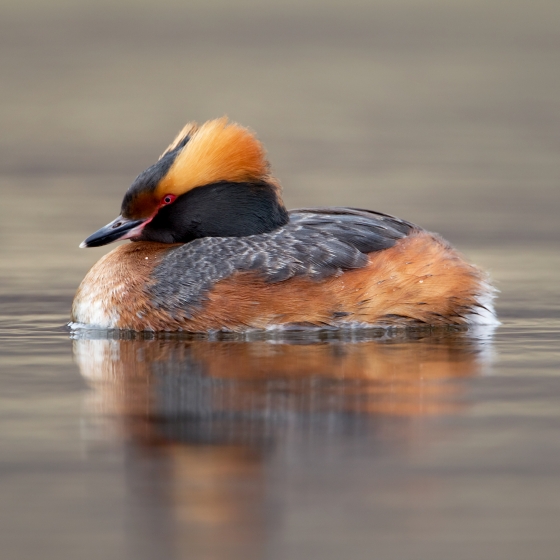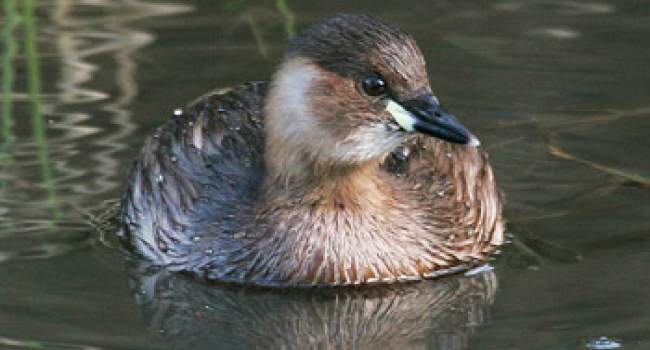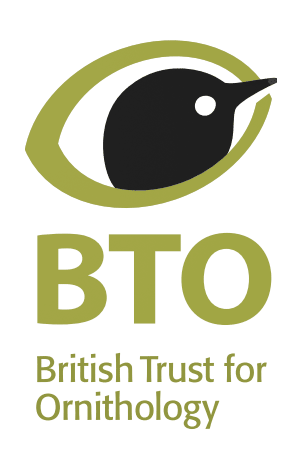Slavonian Grebe
Podiceps auritus (Linnaeus, 1758)
SZ
 SLAGR
SLAGR  110
110

Family: Podicipediformes > Podicipedidae

As with most grebe species, Slavonian Grebes look very different in their summer and winter plumages and choose different habitats in the two seasons.
The story of changing status of Slavonian Grebes in Britain differs between the seasons too. In winter individuals occur close inshore around the coasts of Britain & Ireland, with particular concentrations in sheltered Scottish waters, and south along the North Sea coast of eastern England. Atlas data show a significant expansion in the wintering range of recent decades.
The British breeding population is restricted to a few lochs in the eastern highlands of Scotland, where strikingly chestnut birds – with black head and prominent orange-yellow ‘ear’ tufts – can be glimpsed amongst emergent vegetation. Unfortunately, this tiny population is declining.
Identification
Slavonian Grebe identification is sometimes difficult. The following article may help when identifying Slavonian Grebe.
Identifying winter Grebes

From Great Crested and Red-necked to Slavonian and Black-necked, separating grebes in winter plumage can be challenging. This identification video from the BTO discusses all the features to help identify them with confidence.
- ‹ previous
- 2 of 2
Develop your bird ID skills with our training courses
Our interactive online courses are a great way to develop your bird identification skills, whether you're new to the hobby or a competent birder looking to hone your abilities.
Browse training coursesStatus and Trends
Population size and trends and patterns of distribution based on BTO surveys and atlases with data collected by BTO volunteers.
CONSERVATION STATUS
This species can be found on the following statutory and conservation listings and schedules.
POPULATION CHANGE
Small numbers of Slavonian Grebe breed in Scotland, with a five-year mean of 29 breeding pairs during the period 2015–2019, according to RBBP figures; the Scottish population has declined strongly in the 25 years to 2019 (Eaton et al. 2021) after rising from 49 pairs in 1971 to 73 pairs in 1993 (Balmer et al. 2013). Range losses have occurred across much of Europe and also in North America and the species is consequently listed as Vulnerable on the Global IUCN Red List (BirdLife International 2021).
| UK winter population |
-23% decrease (1995/96 to 2020/21)  |
DISTRIBUTION
In winter, Slavonian Grebes occur around much of the coast of Scotland, with particular concentrations in sheltered waters in the Northern Isles, northwest Scotland, the Moray Firth, the Firth of Forth and Loch Ryan. In England they are found mainly in Northumberland and farther south along the coast from East Anglia to Cornwall. There are scattered records around the Irish coastline. A small breeding population is confined to the eastern Scottish Highlands.
Occupied 10-km squares in UK
| No. occupied in breeding season | 16 |
| % occupied in breeding season | 0.5 |
| No. occupied in winter | 514 |
| % occupied in winter | 17 |
European Distribution Map
DISTRIBUTION CHANGE
Change in occupied 10-km squares in the UK
| % change in range in breeding season (1968–72 to 2008–11) | -20% |
| % change in range in winter (1981–84 to 2007–11) | +67.8% |
SEASONALITY
Slavonian Grebes are most often see in winter, when present from early autumn to late winter/early spring, but also present in the small Scottish breeding range throughout summer.

Movement
Information about movement and migration based on online bird portals (e.g. BirdTrack), Ringing schemes and tracking studies.
RINGING RECOVERIES
View a summary of recoveries in the Online Ringing Report.
Foreign locations of birds ringed or recovered in Britain & Ireland

Biology
Lifecycle and body size information about Slavonian Grebe, including statistics on nesting, eggs and lifespan based on BTO ringing and nest recording data.
SURVIVAL & LONGEVITY
View number ringed each year in the Online Ringing Report
Maximum Age from Ringing 
|
5 years 0 months 15 days (set in 2017) 
|
CODES & CLASSIFICATION
Ring size 
|
F* |
Field Codes 
|
2-letter: SZ | 5-letter code: SLAGR | Euring: 110 |
For information in another language (where available) click on a linked name
Research
Interpretation and scientific publications about Slavonian Grebe from BTO scientists.
CAUSES AND SOLUTIONS
Causes of change
Ewing et al. (2013) did not find any clear evidence linking population declines to climate change but were also unable to discount the possibility that it could occur through indirect mechanisms that they could not consider. In a Scottish study, productivity was affected by a number of factors including predation of eggs by crows, predation of young by pike and disturbance by anglers (Summers et al. 2009). A study at Loch Ruthven found that breeding productivity was positively correlated with chironomid abundance at the site (Brooks et al. 2012). There is no clear evidence to indicate which of these factors (if any) is most likely to have driven population changes.
Links to more information from ConservationEvidence.com
Would you like to search for another species?












Share this page